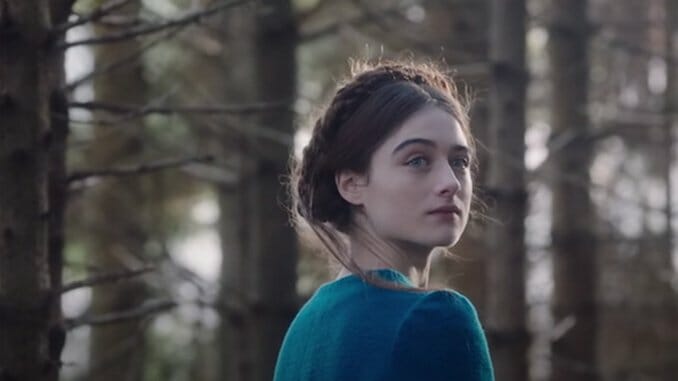
The so-called “Shepherd” sends Selah (Raffey Cassidy) to the hills to deliver a newborn lamb. Instead, she returns with blood-stained hands and the wrath of an almost anthropomorphic ram, who—for the rest of The Other Lamb—follows her around, breathing heavily, angry horns in her face and stony eyes challenging hers.
The horror of The Other Lamb accrues slowly. Director Malgorzata Szumowska is a master of world building; the film is told through cult member Selah’s perspective, with the cult leader, the “Shepherd” (Michiel Huisman), existing as a more-or-less silent and cruel specter. Initially, the followers believe that only the male leader has the right to tell stories, but The Other Lamb skewers the male gaze.
In the film, to see is to know—and to surveil. The leader organizes his all-women cult into two horrifying categories: Those who wear red frocks are forced to be his “wives” and the ones wearing blue are his “daughters,” many of whom, if not all, are his biological daughters (Szumowska obscures some of these details). He knows everyone’s menstrual cycles, and he seems to always be lurking, trying to pluck the next daughter from childhood and make her his wife as soon as she begins her period. His favorite daughter, the pious Selah, however, begins to perceive his insidiousness and grows fearsome of the impending arrival of her period.
Szumowska’s film reflects on the power, and politics, of looking. The compound the cult lives in was built panoptically, with large, open windows so the leader can cast a watchful eye on his followers; his eye, in turn, enforces his will, dividing his followers so they are encouraged to report others’ behavior to him to win his favor. He kicks and maims his least favorite daughter, Tamar (Ailbhe Cowley), and rapes castaway wife Sarah (Denise Gough), who is exiled to live in a shed and tend to those who are on their periods. Cinematographer Michal Englert’s camera follows Selah’s inquisitive gaze, counteracting the leader’s surveillance by observing what, it seems, she’s not supposed to: She stays up late and watches the leader’s house, and the wives who populate it.
Often, she finds the leader looking at her, his image typically obscured by a shadowy light or a muddy window so she can only perceive his eerie outline. The threat of his gaze lingers regardless of whether he is actually watching or not. It is through Selah’s observations that she is able to turn the leader’s gaze on its head and detect the violence below the surface. She makes sense of the hellish cult through her meticulous looking, but also via mysterious visions—or perhaps revelations—of her own that seem to predict the future.
The viewer identifies with Selah’s yearning to thread together images that call out to her; we piece reality together alongside her. The Other Lamb excels in creating a stunning nightmare, but its preoccupation with the visual—the masterful cinematography that seems to offer up a web of symbols to decipher like some sort of living codex—and violence against women (the cult leader often chokes and gags women when he has sex with them) do sometimes distract from Szumowska’s reflections about the patriarchy and internalized misogyny. Szumowska is so focused on images that provoke and haunt and represent that the The Other Lamb veers into the realm of a beautiful revenge film rather than fully develop the nuanced critique of patriarchal structures it hints at.
On the other hand, aesthetics are indeed crucial to the film. The shepherd equates the nostalgic, pastoral beauty of nature (The Other Lamb is probably set among the rolling hills of Ireland, where the film was shot) with his sexist view of women. In his opinion, the cult is his own misogynistic fairytale: It feels purposefully shut off from the 21st century, where the closest thing the cult has to modern technology is a Barbie doll lifted from a follower’s life before joining the fold. For the women, many of whom have been in the cult for decades or were born into it, thi life is the only one they know.
The Other Lamb illustrates the leader’s hypocrital, false feminist teachings—in a sermon, he tells his followers that they should be grateful that he has given them “sisters,” after contributing to the death of one of his wives—and by the glorious ending of the film, in a way, he’s right: His words become prescient, although not in the way he intended them to be. Until that point, the leader created a system that stripped his followers of autonomy, considering them endlessly replaceable along a cyclical string of daughters becoming wives and wives becoming disposable as they age.
Raffey Cassidy’s (The Killing of A Sacred Deer, Vox Lux) strong performance as Selah captures the hero’s transformation from loyal follower to leader in her own right. The supposedly Edenic world of the cult unravels through her eyes and sometimes acerbic wit, and Cassidy vividly portrays the chaos. She quite evocatively illustrates Selah’s interiority as the bearer of the secret history passed down by Sarah, whether that be a facial expression that speaks volumes, or even just the way she walks—often determined and brisk.
As in Ari Aster’s cult thriller Midsommar, viewers can find allusions to fascism and religious extremism in The Other Lamb, but the film is less interested in exploring the leader’s obvious cruelty at length than it is concerned with Selah’s inevitably gory pilgrimage. It’s a resonant tale of a young woman who learns to reject the deeply patriarchal system in which she was raised, to carve out a narrative outside of the one she has been forced to believe. The Other Lamb is a fable, coming-of-age story and revenge film all at once. Selah gets the last word.
Director: Malgorzata Szumowska
Writer: Catherine S. McMullen
Starring: Raffey Cassidy, Michiel Huisman, Denise Gough
Release Date: April 3, 2020